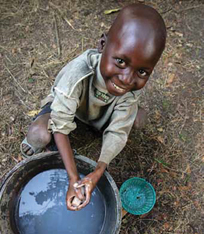4.2.1 Hand washing with soap
The importance of the most obvious hygiene behaviour – thorough hand washing with soap – cannot be overestimated. Many intestinal microorganisms and worms are thought of as causing water- or food-borne diseases, and indeed they are often transmitted by these routes. However, they are also transmitted by the faecal–oral route, in which faecal contamination of the hands is transferred directly to the mouth (e.g. when children suck their fingers or people eat with unwashed hands), or indirectly when pathogens on the hands are transferred to food, drinks or utensils. These diseases are also transmitted by flies landing on faeces and then on food.
In most homes in high-income countries, the availability of soap and clean water for washing is taken for granted; but it is a luxury that millions of people elsewhere in the world can rarely afford (Figure 11).
Think back to Video 1. What facilities did Asafesh have for washing her hands at her Health Post in rural Ethiopia?
Health Posts don’t have running water, so Health Extension Workers like Asafesh have to wash their hands between patients using a plastic bowl and water carried in a bucket from a nearby well. They are trained always to use soap.
Public health educators have increasingly understood the potential impact of hand washing on the incidence of many infectious diseases, as described in a major review article entitled ‘Hygiene: New Hopes, New Horizons’ (Curtis et al. 2011). According to the evidence reviewed by the authors, very significant reduction in diarrhoeal-disease episodes can be achieved by hand washing, especially if soap is used. They conclude that hand washing reduces diarrhoeal illness by around 30%, and if soap is used, the reduction is 43–47%. This huge reduction at very little cost per person justifies the authors’ conclusion that hand washing with soap may be ‘the single most cost-effective way of reducing the global burden of infectious disease’ (Curtis et al., 2011, p. 312).
In addition to transferring diarrhoeal pathogens and intestinal parasites, can you suggest any other infectious conditions that can be transferred by poor hand hygiene?
You might have thought of neonatal tetanus and sepsis (the pathogens are most often transferred to the cut stump of the umbilical cord), infection of the female reproductive tract during childbirth, and eye infections including trachoma (which can be prevented by thoroughly washing the face as well as the hands).
The article also points to the potential impact of other aspects of personal hygiene that can reduce the risk of infection, one of which was also mentioned in Video 1 (the avoidance of open defaecation in fields and the safe disposal of human faeces in well-constructed latrines). How does this practice reduce the risk of diarrhoeal diseases?
The safe disposal of faeces reduces the risk of certain pathogens being transmitted by flies, contaminating food crops or being washed by rain into sources of drinking water.
Another setting in which the importance of hand hygiene has been widely publicised relates to the prevention of infection transmitted between patients and staff in hospitals and other healthcare institutions. It illustrates how relatively simple public health interventions can have a significant impact on an important source of infection, even in high-income countries. This idea is explored in the next section.

